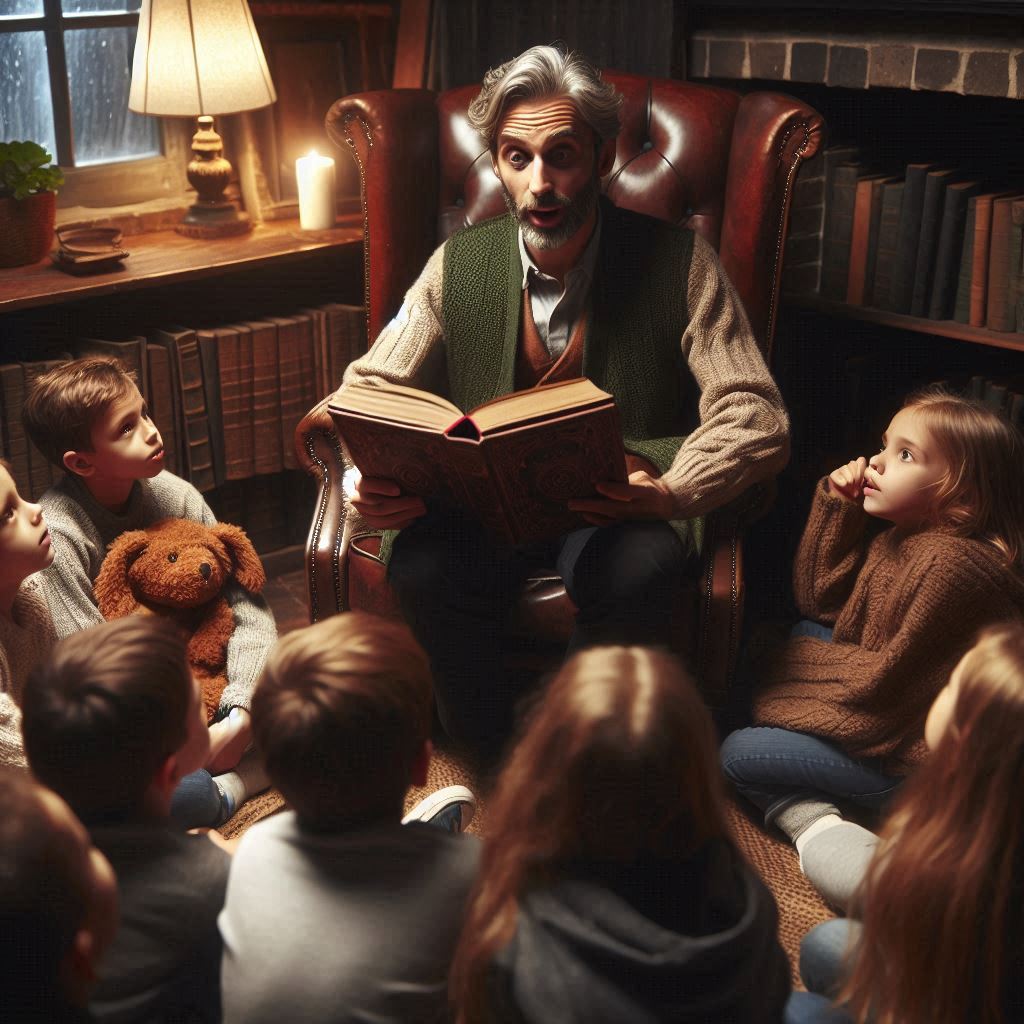Introduction
Overview of the importance of storytelling in child development
Storytelling plays a vital role in child development.
It fosters imagination and creativity.
Children learn empathy as they explore diverse characters and situations.
Furthermore, storytelling helps improve language skills and boosts cognitive growth.
AI technology and its role in enhancing storytelling
Artificial intelligence (AI) technology has transformed many areas of our lives.
In storytelling, AI enhances the creation and delivery of narratives.
It crafts personalized experiences by adjusting plots and characters based on children’s preferences.
This technology introduces adaptive storytelling, where narratives evolve based on a child’s reactions.
Purpose of the blog post: To explore the intersection of AI and children’s animated love stories
The purpose of this blog post is to explore the intersection of AI and children’s animated love stories.
Animated love stories captivate young audiences with charm and humor.
AI can infuse creativity, making these stories more engaging and meaningful.
It also allows creators to produce unique narratives that resonate with children.
By employing AI, we can analyze what makes stories enchanting.
AI examines successful themes and character interactions that children enjoy.
This analysis helps in crafting animated love stories that connect on an emotional level.
Moreover, AI empowers children to participate in storytelling.
They can input their ideas and see them transformed into animated scenes.
This interaction not only entertains but also empowers children to express themselves creatively.
Through AI, stories can incorporate relatable challenges and resolutions.
Children learn about love, friendship, and kindness through these narratives.
AI ensures that lessons remain age-appropriate while still resonating with young audiences.
Therefore, the fusion of AI technology and children’s animated love stories presents new opportunities.
It enriches storytelling, offering children experiences that enhance their emotional and social development.
As we unveil this captivating intersection, we invite you to explore its magic further.
The Evolution of Storytelling
Storytelling has undergone a remarkable journey throughout human history.
From ancient oral traditions to modern digital mediums, storytelling techniques have evolved significantly.
Each stage of this evolution reflects the cultures and technologies of its time.
Historical Perspective on Storytelling Techniques
Initially, storytelling served as a communal activity.
Tribes would gather around fires, sharing tales that conveyed morals, history, and culture.
These stories relied heavily on oral traditions, with no written records.
They were passed down through generations, evolving with each retelling.
- Oral Traditions: Stories shared verbally, emphasizing memory and performance.
- Written Word: The advent of writing allowed stories to be recorded and disseminated widely.
- Print Medium: The printing press revolutionized storytelling by making books accessible to the masses.
With written stories, authors could explore complex characters and intricate plots.
Readers engaged their imaginations, visualizing worlds and events in unique ways.
This era allowed storytelling to transition from the ephemeral to the permanent.
Transition from Traditional Storytelling to Animated Narratives
The introduction of animation marked another significant shift in storytelling.
We Design & Develop Websites, Android & iOS Apps
Looking to transform your digital presence? We specialize in creating stunning websites and powerful mobile apps for Android and iOS. Let us bring your vision to life with innovative, tailored solutions!
Get Started TodayAnimation allowed storytellers to present their narratives visually, bridging the gap between written and visual art forms.
Children, in particular, became captivated by the colorful characters and engaging plots of animated stories.
- Early Animation: Began in the early 20th century with short films and flipbooks.
- Classic Disney: Pioneered feature-length animated films, captivating audiences worldwide.
- Modern Animation: Advanced technology has led to CGI and 3D animation, creating immersive experiences.
Animated narratives provide visual stimulation, appealing to children’s senses.
Moveable images and vivid color palettes grab attention, making stories more engaging.
Animation also allows for fantastical elements, sparking children’s imaginations in ways traditional storytelling may not.
Introduction of Technology in Storytelling and Its Impact on Creativity
As technology advanced, the storytelling landscape expanded dramatically.
Digital platforms revolutionized how stories are told and consumed.
From e-books to interactive apps, technology opened new avenues for creativity and engagement.
- Digital Storytelling: Combines text, images, and sound to create immersive narratives.
- Interactive Media: Allows children to influence story outcomes, enhancing engagement.
- AI in Storytelling: Artificial intelligence adds another layer, personalizing stories for individual readers.
AI-driven platforms can analyze a child’s preferences and tailor stories accordingly.
This personalization enhances children’s enjoyment and fosters a deeper connection to the narratives.
Children experience stories that resonate with their interests, boosting their love for reading and storytelling.
Moreover, technology has democratized storytelling. Anyone with a smartphone can create and share stories.
This accessibility encourages diverse voices and perspectives, enriching the storytelling landscape.
Various formats, such as podcasts and video storytelling, have emerged, expanding the reach and impact of narratives.
Shaping the Future of Children’s Animated Love Stories
As storytelling evolves, children’s animated love stories reflect these changes.
They offer lessons about relationships, kindness, and empathy.
By incorporating themes of love in a child-friendly manner, creators can inspire emotional intelligence in young audiences.
- Diverse Characters: Animation celebrates varied relationships, fostering inclusion and acceptance.
- Engaging Plots: Love stories captivate children, teaching essential life lessons.
- Interactive Elements: Engage viewers, allowing them to explore concepts of friendship and love.
Animated love stories utilize humor and warmth to convey messages.
They provide a platform for children to understand their feelings.
Through characters and narratives, they learn how to express affection and resolve conflicts.
This evolution of storytelling illustrates how technology and creativity intersect.
AI-driven storytelling offers new possibilities.
Children can experience narratives that are not only entertaining but also enriching.
As creators harness these technologies, they can craft experiences that foster empathy, understanding, and love.
The journey of storytelling continues to unfold.
From ancient oral traditions to contemporary animated love stories, each era contributes to the vibrant tapestry of narratives.
As technology evolves, so too does the potential for creativity in storytelling.
With AI-powered storytelling on the horizon, the future brims with possibilities for children’s animated narratives.
These narratives will not only entertain but also educate, instilling values that promote emotional growth.
Indeed, storytelling remains a powerful tool.
It connects us, reflects our experiences, and shapes our futures.
As we explore the integration of AI in narrative forms, we look forward to seeing how these technologies will enhance the art of storytelling.
Perhaps the next great children’s love story is just around the corner, waiting to tug at our heartstrings.
Read: Interactive Virtual Reality Experience for Long-Distance Couples
AI Technology in Storytelling
Artificial Intelligence (AI) has revolutionized various fields, and storytelling is no exception.
We Design & Develop Websites, Android & iOS Apps
Looking to transform your digital presence? We specialize in creating stunning websites and powerful mobile apps for Android and iOS. Let us bring your vision to life with innovative, tailored solutions!
Get Started TodayThis section delves deep into the elements of AI that fuel the narrative creation process and examines how we can harness these technologies for children’s animated love stories.
Understanding AI’s components can enhance the creativity and depth of storytelling.
What is Artificial Intelligence?
Artificial intelligence refers to the ability of machines to perform tasks typically requiring human intelligence.
These tasks include understanding natural language, recognizing patterns, and making decisions.
Several key components contribute to AI’s storytelling capability.
- Machine Learning (ML): This involves algorithms that allow computers to learn from data. ML helps AI understand storytelling patterns.
- Natural Language Processing (NLP): NLP enables machines to comprehend and generate human language. It is crucial for dialogue in narratives.
- Computer Vision: This aids AI in interpreting visual information, enhancing animated storytelling through imagery and scenes.
- Generative Algorithms: These algorithms create new content by learning from existing information. They synthesize unique narratives, characters, and scenarios.
How AI Algorithms Create Narratives and Characters
AI leverages various methods to generate engaging narratives and compelling characters.
Understanding this process can illuminate the magic behind AI-powered storytelling.
Data Analysis and Pattern Recognition
AI algorithms analyze vast datasets of stories to identify common themes and structures.
They recognize narrative arcs, character development, and emotional beats.
This analysis lays the groundwork for generating coherent narratives.
Character Development
AI creates characters by using attributes gathered from existing stories.
It considers aspects like:
- Personality Traits: The algorithms define characters through consistent behaviors, strengths, and weaknesses.
- Backstory: They craft rich backstories that enhance character depth and relatability.
- Relationships: AI explores dynamics, such as friendships, rivalries, and romances, enriching storylines with character interactions.
Narrative Construction
The narrative construction process involves organizing character journeys and plot points.
AI employs various techniques:
- Plot Generation: Using templates, AI designs engaging plots with twists and emotional arcs.
- Dialogue Creation: NLP assists in crafting natural and relatable dialogue. This adds authenticity to character interactions.
- Emotion Detection: Algorithms analyze sentiment to enrich stories with emotional depth.
Generating Unique Scenarios
AI tools can create countless scenarios tailored to different themes and audiences.
They leverage learned patterns to invent fresh ideas while maintaining coherence within the narrative.
This unique capacity significantly enhances storytelling possibilities.
Examples of Existing AI Storytelling Applications and Tools
Several applications in the market utilize AI technologies to enhance storytelling.
These tools cater to various needs, from writing assistance to animation development.
Here are some notable examples:
- Storybird: This platform uses AI to assist writers in generating story prompts and artistic visuals. It inspires creativity for children’s stories.
- ChatGPT: Developed by OpenAI, it generates narrative content, character dialogue, and helps brainstorm story ideas. Its natural language capabilities facilitate interactive storytelling.
- DeepStory: This AI tool enables users to craft stories through a collaborative approach. It learns from user input, improving its narrative suggestions over time.
- Plotagon: An animation tool integrating AI to generate animated scenes from written scripts. Users see their stories come to life visually, enhancing storytelling engagement.
- Twine: This open-source tool supports interactive storytelling. Users create branching narratives, allowing for unique storytelling experiences.
Each of these applications showcases the versatility of AI in the storytelling process.
They empower users to experiment with narrative formats and character development, opening doors for creativity.
AI technology considerably enhances the storytelling landscape, making it more transformative, engaging, and interactive.
Understanding AI’s components enables storytellers to create more impactful narratives and memorable characters.
With tools designed for both experienced writers and beginners, AI-powered storytelling can reshape how children experience animated love stories.
By harnessing this technology, we can inspire a new generation of creative thinkers and storytellers.
Incorporating AI in storytelling fosters innovation, flexibility, and accessibility.
As these technologies continue to evolve, they will undoubtedly open up new avenues for storytelling.
The future of AI-powered storytelling appears bright, especially within children’s animated narratives.
Engaging hearts and minds remains at the core of what storytelling aims to achieve.
Read: Machine Learning Algorithms Finding Your Perfect Match
Characteristics of Effective Children’s Love Stories
Children’s love stories differ significantly from those aimed at adults.
These stories simplify complex emotions into relatable themes that resonate with young audiences.
Effective storytelling for children emphasizes positive values like friendship, kindness, and empathy.
The right themes foster emotional intelligence and understanding in young minds.
We Design & Develop Websites, Android & iOS Apps
Looking to transform your digital presence? We specialize in creating stunning websites and powerful mobile apps for Android and iOS. Let us bring your vision to life with innovative, tailored solutions!
Get Started TodayKey Themes in Children’s Love Stories
Several themes work exceptionally well in children’s love stories.
They create connections and impart valuable lessons.
Here are some positive themes to explore:
- Friendship: Stories about friendship highlight the importance of companionship. They teach children how to connect and support each other.
- Kindness: Kindness as a theme encourages empathy. Characters demonstrate helpfulness and compassion toward each other.
- Empathy: Empathy and understanding form core elements of effective stories. They help children learn how to relate to others’ feelings.
- Acceptance: Acceptance teaches tolerance and respect for differences. It emphasizes inclusion and the beauty of diversity.
- Healing: Healing explores emotions such as grief or loss. It shows how supportive love can help overcome challenges.
The Importance of Age-Appropriate Content
Age-appropriate content plays a critical role in children’s love stories.
Understanding a child’s developmental stage is essential.
Content that is too complex can lead to confusion or misunderstanding.
Simplified narratives resonate better and maintain engagement.
Age-appropriate content impacts young audiences profoundly.
It can shape their perceptions of relationships and emotional connections.
Here’s why age-appropriate themes matter:
- Developmental Suitability: Different age groups grasp ideas differently. Suitable content matches their cognitive and emotional understanding.
- Emotional Impact: Stories that relate to children’s lives can evoke emotional responses. These connections foster empathy and emotional growth.
- Social Connections: Children replicate lessons from stories in their lives. Age-appropriate content provides a safe space for exploring relationships.
- Positive Role Models: Characters demonstrate appropriate behavior. They offer examples of kindness, love, and friendship for children to emulate.
- Enjoyment and Engagement: Engaging stories capture children’s attention. They encourage imagination and creativity in exploring emotions.
The Role of Humor and Adventure
Humor and adventure greatly enhance children’s love stories, making them more engaging and relatable.
Children naturally enjoy fun, exciting narratives that keep them captivated.
Humor lightens emotional themes, making them accessible to young audiences.
Here are key benefits of humor:
- Increased Engagement: Funny situations keep children interested, making the story enjoyable.
- Emotion Regulation: Laughter helps children process emotions and maintain a positive outlook.
- Easy Relatability: Comedic flaws in characters help children relate and feel understood.
- Enhanced Comprehension: Humor simplifies complex lessons, making them easier to grasp.
- Fostering Connection: Shared funny moments encourage conversations between children and caregivers.
Adventure also plays a crucial role in maintaining children’s interest.
It sparks curiosity and inspires children to explore new ideas.
Here’s how adventure benefits children’s love stories:
- Exploration of Emotions: Adventures let characters experience diverse emotions, helping children understand love and friendship.
- Lessons in Teamwork: Many adventures highlight the importance of collaboration and support.
- Creative Imagination: Adventure stimulates children’s creativity by introducing them to imaginative worlds.
- Conflict Resolution: Characters face and overcome challenges, teaching problem-solving skills.
- Building Resilience: Adventures show that perseverance leads to success, even after setbacks.
Effective children’s love stories convey essential themes like friendship, kindness, and empathy.
Humor and adventure transform stories into immersive experiences, nurturing emotional intelligence, creativity, and connection.
AI-driven storytelling continues to bring these timeless themes to life, inspiring children everywhere.
Read: Love Analytics: Using Data Science to Understand Relationships

Integrating AI in Children’s Animated Love Stories
The world of children’s animated love stories is undergoing a significant transformation.
With advancements in Artificial Intelligence (AI), creators can now enhance character development and dialogue like never before.
AI technologies empower storytellers to craft engaging narratives that resonate with young audiences.
Enhancing Character Development
AI can revolutionize the way characters are developed in animated love stories.
This technology allows for deeper insights into character traits and emotional arcs.
Here are several ways AI facilitates enhanced character development:
- Behavioral Analysis: AI algorithms analyze how characters behave in various situations. This data helps creators craft believable and relatable characters.
- Emotional Mapping: AI tools can track a character’s emotional journey. They help writers understand how emotions shift throughout the story.
- Customized Character Interactions: AI can generate unique interactions between characters. This creates a dynamic dialogue that evolves with the story.
- Age-Appropriate Characteristics: AI ensures that character traits align with the target age group. This makes characters more relatable for children.
Through these methods, AI enriches the depth of characters, making them more immersive for children.
This complexity engages young viewers and helps them understand various emotions.
Revolutionizing Dialogue
Dialogue is a crucial component of storytelling, and AI significantly impacts this area.
Advanced algorithms can analyze speech patterns and tone to create compelling dialogue.
Here are several ways AI enhances dialogue writing:
- Natural Language Processing: AI understands and generates human-like dialogue. This technology enables characters to speak in ways that feel real and relatable.
- Context Awareness: AI considers the context of conversations to generate appropriate responses. This leads to more meaningful exchanges between characters.
- Diverse Language Styles: AI allows for the creation of characters that speak in distinct styles. This diversity adds flavor to the dialogue and helps establish unique personalities.
- Interactive Storytelling: AI can facilitate interactive dialogue. Children can influence story outcomes through their choices, enhancing engagement.
The impact of AI on dialogue elevates the storytelling experience.
Children become invested in the narrative and the relationships between characters.
Case Studies of Successful AI-Powered Animated Love Stories
Several animated love stories have successfully integrated AI to great effect.
We Design & Develop Websites, Android & iOS Apps
Looking to transform your digital presence? We specialize in creating stunning websites and powerful mobile apps for Android and iOS. Let us bring your vision to life with innovative, tailored solutions!
Get Started TodayHere are some noteworthy examples that demonstrate the potential of AI in children’s storytelling:
- “The Adventures of Young Love”: This series utilized AI to dynamically create storylines based on viewer preferences. Personalized narratives improved viewer attachment to the characters.
- “A Magical Heart”: In this animated film, AI-generated dialogue helped weave complex emotional expressions.
It enabled characters to engage in discussions about love and friendship that resonated with young audiences. - “Friendship Blossoms”: This series featured an AI-powered storytelling engine. It crafted unique episodes based on the audience’s reactions, fostering a sense of community among viewers.
- “AI Heart Heroes”: This show focused on characters who used AI to solve problems in their relationships. It taught children about communication and conflict resolution in a fun, animated way.
These case studies illustrate the positive impact AI can have on animated love stories.
They demonstrate how technology can enhance storytelling while making it more relatable for children.
Benefits of Personalized Storytelling through AI Algorithms
AI algorithms allow for personalized storytelling opportunities that extend beyond traditional methods.
Here are several benefits that come from using AI in children’s animated love stories:
- Tailored Experiences: Each child can receive a different version of the same story. AI adapts the narrative to the keys that resonate with individual viewers.
- Enhanced Engagement: Personalization keeps children engaged as they can see themselves in the characters. This connection deepens their interest in the story.
- Boosted Emotional Understanding: Tailored stories can present themes relevant to a child’s life. This encourages discussions about emotions and relationships.
- Feedback Integration: AI can analyze viewer feedback to improve future stories. This ongoing evolution helps keep the content fresh and exciting.
Through these benefits, AI redefines how children experience animated love stories.
By offering personalized narratives, creators can foster emotional connections.
Integrating AI into children’s animated love stories offers numerous opportunities for storytelling enhancement.
From character development to dynamic dialogues, the potential is tremendous.
Case studies demonstrate the lasting impact AI has had on engaging young viewers.
Additionally, personalized storytelling paves the way for deeper emotional insights.
As technology advances, we can expect further innovations that enhance the storytelling experience.
AI-driven methods empower creators to connect with young audiences in meaningful ways.
Embracing these technologies will lead to a future rich with creativity and imagination in children’s animated love stories.
Read: The Role of Cybersecurity in Protecting Digital Love Lives
The Role of Visuals and Animation
Animation serves as a powerful medium for storytelling, especially in children’s love stories.
It captivates young audiences through vibrant visuals and engaging narratives.
The role of animation is essential to create memorable tales that resonate with children.
Different animation styles can evoke various emotions, making them vital to the storytelling process.
With the rise of AI technology, we can enhance animation quality significantly.
Importance of Animation Styles in Storytelling
Animation styles directly influence the narrative experience.
Here are some crucial aspects to consider:
- Visual Appeal: Vibrant colors and imaginative designs attract children. A striking visual style keeps their attention throughout the story.
- Emotional Tone: Different styles evoke different feelings. For example, soft, rounded characters create warmth, while sharp lines might suggest tension.
- Character Development: The style influences how characters are perceived. An exaggerated style can amplify emotional responses during key moments.
- World-Building: Styles can create immersive worlds. A whimsical approach can transport children to fantastical lands of adventure and love.
How AI Can Aid in Creating Visually Appealing Graphics
AI technology provides exciting tools for creating stunning visuals tailored for children’s love stories.
Here are some ways AI contributes:
- Rapid Prototyping: AI can generate various animation styles quickly. Animators can experiment with designs without extensive manual work.
- Customization: AI algorithms create personalized content for different audiences. Tailoring elements to fit specific age groups optimizes engagement.
- Enhanced Visual Fidelity: Machine learning improves image quality and fluidity. Viewers enjoy smoother animations and sharper visuals.
- Character Behavior Modeling: AI can simulate realistic character movements. This makes interactions feel authentic and relatable to viewers.
- Color Palette Optimization: AI analyzes emotional resonance of colors. It can suggest palettes that enhance thematic elements in stories.
Examples of Animation Techniques That Enhance Emotional Connection
Animation techniques play a key role in deepening emotional connections within love stories.
These methods effectively convey feelings, especially for young audiences.
Here are some notable techniques:
- Facial Expressions: Detailed animations of faces convey emotions clearly. Children can easily recognize joy, sadness, or love through expressive characters.
- Body Language: Subtle gestures and movements enhance the story. A character’s posture communicates their feelings without the need for words.
- Color Shifts: Changes in color intensity mirror emotions. Bright hues signify happiness, while muted tones express sadness.
- Framing and Angles: Camera perspectives influence viewers’ perception. Close-ups during emotional moments create a sense of intimacy.
- Music and Sound Effects: The right music and sound reinforce visuals. A well-chosen score amplifies emotions in critical scenes.
Animation, combined with these elements, creates an immersive and meaningful experience.
Children form deeper emotional bonds with stories that reflect their own feelings.
AI technology now offers new possibilities for animators, allowing them to enhance the storytelling process.
Innovative tools enable precise refinement of techniques, enriching the emotional depth of narratives.
In fact, animation techniques, powered by AI, significantly enhance love stories in children’s media.
By understanding and using these methods, animators can create stories that not only entertain but also teach values like love, friendship, and empathy.
The future of AI in animation holds endless potential, promising even more captivating stories for young audiences.
Ethical Considerations in AI-Powered Storytelling
AI-powered storytelling in children’s media has transformed how we create narratives.
We Design & Develop Websites, Android & iOS Apps
Looking to transform your digital presence? We specialize in creating stunning websites and powerful mobile apps for Android and iOS. Let us bring your vision to life with innovative, tailored solutions!
Get Started TodayHowever, this innovation brings significant ethical considerations.
Understanding these implications is crucial for parents, educators, and creators.
Implications of Using AI in Children’s Media
The integration of AI in storytelling impacts various aspects of children’s media.
Here are some key implications:
- Responsibility to Nurture Creativity: AI can produce stories quickly. However, it should not stifle children’s creativity.
- Quality Control: AI-generated content requires oversight to ensure accuracy and appropriateness.
- Emotional Engagement: AI storytelling must convey genuine emotions. Children need authentic connections to understand love and relationships.
- Accessibility: AI can make stories accessible to diverse audiences. This can foster inclusivity, but quality must remain intact.
- Customization vs. Generic Content: While AI can personalize stories, it can also push similar narratives that may lack originality.
These implications highlight the balance between innovation and care in employing AI technologies for children’s storytelling.
Concerns Regarding Content Authenticity
The authenticity of content produced by AI raises important concerns.
Quality storytelling requires a human touch, deep understanding, and emotional intelligence.
Here are prevalent concerns:
- Lack of Emotional Depth: AI may create stories that lack emotional understanding, leaving children unengaged.
- Reinforcement of Stereotypes: AI systems can perpetuate existing biases if fed biased data, affecting children’s perceptions of the world.
- Homogenization of Content: AI-generated narratives may deliver familiar tropes, stifling diversity in storytelling.
- Impact on Critical Thinking: Children may stop questioning narratives if they overly trust AI-generated content.
- Intellectual Property Issues: Concerns arise regarding ownership and copyright of stories created by AI.
These issues highlight the need for vigilance in AI storytelling for children.
Content creators must be conscious of these authenticity concerns.
Influence of AI on Young Minds
Children are impressionable, making their exposure to media highly consequential.
AI’s influence can shape their views, thoughts, and values.
- Formation of Relationships: Children learn about friendship and love through stories. AI must present accurate relationship dynamics.
- Understanding Emotions: Well-crafted narratives help children understand their feelings. AI should foster this development, rather than hinder it.
- Social Norms and Values: Stories convey cultural norms and values. AI must not misrepresent or simplify crucial cultural messages.
- Behavior Modeling: Children often mimic behavior presented in stories. Ethical storytelling can guide positive interactions and emotional responses.
- Development of Imagination: AI should encourage imaginative thinking rather than restrict it to linear narratives.
The impact of AI on young minds extends beyond entertainment; it forms the basis of their understanding of interpersonal connections.
Strategies for Responsible Use of AI Technologies
To utilize AI responsibly in children’s storytelling, fundamental strategies are necessary.
Here are practical approaches that creators and developers can adopt:
- Human Oversight: Always involve human creators to oversee AI-generated content. This ensures balance and emotional intelligence.
- Diverse Input Data: Train AI with diverse data to foster varied narratives that represent multiple perspectives.
- Content Guidelines: Establish strict guidelines for AI-generated content, focusing on themes of positivity and inclusivity.
- Transparency: Be transparent about AI’s role in storytelling. Let parents and children know how narratives are created.
- Collaborative Creation: Encourage collaborations between AI technologies and skilled storytellers to enhance content quality.
These strategies promote responsible and ethical AI utilization while encouraging enriching storytelling experiences for children.
The ethical considerations involved in AI-powered storytelling are crucial for protecting children’s emotional development.
As creators navigate this landscape, they must prioritize authenticity, emotional connection, and diverse narratives.
By implementing responsible strategies, they can harness AI’s potential while ensuring that children receive rich, meaningful storytelling experiences.
Balancing technology and empathy will ultimately shape the future of children’s media in a positive and impactful manner.
The Future of AI in Children’s Love Stories
The advancement of artificial intelligence is transforming various aspects of our lives, including storytelling.
Children’s love stories, a beloved genre, are no exception.
AI will shape the future of storytelling in profound ways.
Here, we will discuss predictions about these changes, the potential for interactive storytelling, and encourage content creators to embrace innovation.
Predictions on How AI Will Shape the Future of Storytelling
AI technologies are evolving, bringing significant changes to how stories are created and experienced.
Here are a few predictions about these transformations:
- Personalized Content: AI will enable the creation of personalized love stories for children. By analyzing preferences, AI can tailor narratives to individual tastes.
- Dynamic Narratives: AI can generate dynamic narratives that adapt in real-time to audience reactions. This innovation could make storytelling more engaging and interactive.
- Enhanced Character Development: AI technologies can facilitate rich character development. Characters can evolve based on audience feedback or predefined pathways.
- Automated Illustration: AI can aid in creating illustrations that sync with the narrative. Illustrations will change or animate according to the story’s mood and tone.
- Multi-layered Stories: AI can craft multi-layered stories rich in subtext. This complexity can introduce children to themes of friendship, empathy, and cooperation.
Potential for Interactive Storytelling
The emergence of AI opens doors to interactive storytelling.
This format engages children in new ways, fostering creativity and enhancing their learning experiences.
Here are some potential developments:
- Choose Your Adventure: Children can interact with the narrative, making choices that affect the outcome. This format makes storytelling a participatory activity.
- Augmented Reality Experiences: AI-driven augmented reality (AR) can immerse children in love stories. They can interact with characters and settings, blurring the line between reality and fiction.
- Voice Interaction: Artificial intelligence can enable children to use their voices to influence stories. This feature allows them to participate actively and express their preferences.
- Gamification: Love stories can incorporate gamified elements like challenges or quests. Children can learn problem-solving skills while exploring narratives.
- Collaborative Storytelling: AI can facilitate collaborative storytelling among children. They can work together to create stories, fostering teamwork and communication.
Encouragement for Content Creators to Embrace Innovative Technologies
As AI continues to revolutionize storytelling, content creators must embrace these technologies.
This encouragement comes with several compelling reasons:
- Stay Relevant: In a rapidly changing landscape, integrating AI keeps content fresh and relevant. Creators risk becoming obsolete if they resist change.
- Enhance Educational Value: By leveraging AI, creators can increase the educational value of stories. Incorporating lessons about love, friendship, and empathy enriches children’s experiences.
- Broaden Audience Reach: Innovative storytelling formats attract a wider audience. Engaging stories resonate with children and parents alike, increasing marketability.
- Encourage Diversity: AI can help create diverse characters and narratives. Representing various cultures and backgrounds enhances understanding and inclusivity.
- Foster Creativity: AI tools empower creators to explore new storytelling avenues. This exploration can lead to groundbreaking narratives that captivate young audiences.
The future of AI in children’s love stories is bright and full of potential.
With personalized content and dynamic narratives, AI will significantly enhance storytelling experiences.
Interactive storytelling promises to engage children in ways we have yet to imagine.
The call for content creators to embrace innovative technologies is clear.
We Design & Develop Websites, Android & iOS Apps
Looking to transform your digital presence? We specialize in creating stunning websites and powerful mobile apps for Android and iOS. Let us bring your vision to life with innovative, tailored solutions!
Get Started TodayAs the landscape of storytelling evolves, staying attuned to these changes will benefit everyone, especially the children who benefit from these rich, imaginative tales.
By embracing AI, we can ensure that future generations will enjoy stories filled with love, friendship, and adventure.
We invite content creators to explore these opportunities and help shape the next section in the enchanting world of children’s storytelling.
Conclusion
Recap of the significance of merging AI and storytelling for children
In summary, merging AI and storytelling significantly transforms children’s narratives.
It creates rich, immersive experiences for young audiences.
AI acts as a creative partner, inviting children to explore diverse storylines.
Through interactive storytelling, kids engage more actively with the narrative.
This technology empowers budding storytellers.
Children can shape their stories, influencing plots and characters.
By doing so, AI enhances creativity and imagination in young minds.
The delight in discovering new possibilities makes storytelling even more exciting.
Furthermore, AI analyzes children’s preferences.
By understanding what themes resonate, it tailors narratives to support their emotional growth.
Themes of empathy, friendship, and love become more relatable.
This personalization fosters a deeper connection with stories.
Moreover, AI collaborates with artists and animators.
It allows for visually stunning animations that captivate and entertain children.
Vibrant colors and lifelike characters enhance storytelling, making narratives more engaging.
This combination stimulates both visual and emotional learning.
In the age of digital connectivity, AI-powered storytelling offers endless potential.
It adapts to various formats, from books to interactive media.
This versatility ensures storytelling remains relevant in children’s lives.
Final thoughts on the potential of AI to create enriching, engaging narratives
Final thoughts underscore the importance of this fusion.
AI can generate narratives that are even more enriching and dynamic.
It offers a platform that resonates with every child’s unique imagination and curiosity.
We invite our readers to explore the wondrous world of AI-powered storytelling.
Discover its role in children’s literature and media.
Engage with stories that adapt and grow alongside young audiences.
Let imagination flourish as technology inspires the next generation of storytellers.
Before You Go…
Hey, thank you for reading this blog post to the end. I hope it was helpful. Let me tell you a little bit about Nicholas Idoko Technologies.
We help businesses and companies build an online presence by developing web, mobile, desktop, and blockchain applications.
We also help aspiring software developers and programmers learn the skills they need to have a successful career.
Take your first step to becoming a programming expert by joining our Learn To Code academy today!
Be sure to contact us if you need more information or have any questions! We are readily available.
Put Your Tech Company on the Map!
Get featured on Nicholas Idoko’s Blog for just $200. Showcase your business, boost credibility, and reach a growing audience eager for tech solutions.
We Design & Develop Websites, Android & iOS Apps
Looking to transform your digital presence? We specialize in creating stunning websites and powerful mobile apps for Android and iOS. Let us bring your vision to life with innovative, tailored solutions!
Get Started Today










